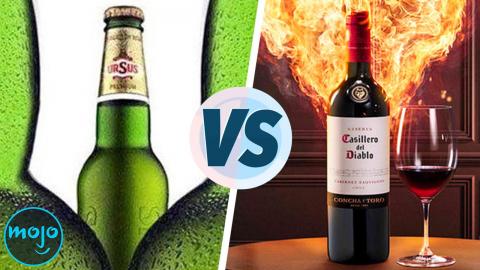Wine Vs Beer

ROUND 1: Flavor Complexity
The allure of wine lies in its intricate flavor profile, a result of the fermentation process involving grapes and the influence of terroir. Each varietal boasts a unique set of characteristics, from the boldness of a Cabernet Sauvignon to the delicate notes of a Chardonnay. The aging process further enriches the taste, offering a spectrum that ranges from fruity and floral to oaky and spicy. This complexity appeals to connoisseurs seeking a nuanced and evolving experience with each sip. The artistry of winemaking and the potential for exquisite pairings with food contribute to wine's reputation as a sophisticated beverage. While beer may not possess the same intricate nuances as wine, its charm lies in the diversity of flavors within its own realm. Craft brewers worldwide constantly experiment with various hops, malts, and yeast strains, creating a vast spectrum of beer styles. From hoppy IPAs to rich stouts, beer enthusiasts can explore a plethora of tastes, each with its own character. The approachability of beer, with its wide range of flavors, attracts those who appreciate a more casual and diverse drinking experience. Choosing between the deliciousness of wine and beer is an almost impossible task. But for its incredible range of flavors and styles, we’re giving the nod to beer. WINNER: Wine 0 / Beer 1
ROUND 2: Cultural and Social Significance
Wine has long been associated with sophistication and cultural refinement. It plays a central role in many societies' rituals, celebrations, and dining experiences. The act of sharing a bottle, discussing its origin, and savoring the complex notes can enhance social interactions. Wine tasting events and vineyard tours offer opportunities for cultural exploration and education, fostering a sense of connection to history and tradition. Beer, on the other hand, has a more casual and communal reputation. It is deeply ingrained in social gatherings, sports events, and local traditions. The accessibility of beer, both in terms of cost and familiarity, makes it a staple in various cultural contexts. Beer fosters a relaxed and convivial atmosphere, encouraging camaraderie and shared experiences. Whether at a pub, a backyard barbecue, or a music festival, beer often serves as a unifying element, bringing people together in a more laid-back setting. Again, this is a really close one, but for its influential role in history, religion and art, we’re going with wine. WINNER: Wine 1 / Beer 1
ROUND 3: Pairing with Food
Wine has well-earned its place as a classic companion to fine dining. The diverse range of wine styles allows for precise pairings with various dishes, enhancing the dining experience. The acidity in wines can cut through rich and fatty foods, while the tannins in red wines complement the flavor of meats. The art of pairing wine with food is a skill appreciated by chefs and enthusiasts alike, adding a layer of sophistication to culinary adventures. Beer, with its carbonation and diverse flavor profiles, also pairs exceptionally well with a wide array of foods. From the crispness of a pilsner cleansing the palate to the robust flavors of a stout complementing the richness of chocolate desserts, beer provides versatility in pairing. Beer's ability to match the intensity and complexity of various cuisines, from spicy curries to grilled meats, makes it a favorite in more casual and diverse dining settings. Even though beer pairs well with many foods, wine is particularly famed for its ability to elevate meals. This one goes to wine. WINNER: Wine 2 / Beer 1
ROUND 4: Production and Aging Process
The production of wine involves a meticulous and often time-consuming process. From the careful cultivation of grapevines to the harvest, crushing, fermentation, and aging, winemaking is an art that requires patience and expertise. The influence of factors such as climate, soil, and grape variety contributes to the unique characteristics of each wine. The aging process, whether in stainless steel tanks, oak barrels, or bottles, further refines the flavors, allowing them to evolve over time. Wine enthusiasts appreciate the craftsmanship involved in creating a bottle, as well as the anticipation that comes with aging and discovering how a wine matures. While beer production lacks the lengthy aging periods characteristic of wine, it has its own intricate process. Brewers carefully select malted grains, hops, yeast, and water to create a balanced and flavorful brew. The fermentation and conditioning stages, though shorter than winemaking, are crucial for achieving the desired taste and carbonation. Some beer styles, such as barrel-aged varieties, incorporate elements of aging, imparting additional complexity. The relatively shorter production timeline of beer allows for a quicker turnover of styles, contributing to the dynamic and ever-evolving landscape of craft beer. Wine has a dizzying array of styles, but the modern microbrew revolution has expanded the horizons of beer styles in an incredible way. This one’s a round of beer! WINNER: Wine 2 / Beer 2
ROUND 5: Accessibility and Affordability
The perception of wine as a more upscale beverage can sometimes lead to the assumption that it is less accessible or more expensive. While there are certainly rare and costly wines, a wide range of affordable options is available. Many regions produce quality wines at various price points, making wine accessible to a broad audience. Additionally, the advent of box wines, canned wines, and innovative packaging has further increased convenience and affordability, challenging the notion that wine is exclusively for the elite. Beer, often historically considered a working-class drink, remains a symbol of accessibility. The variety of beer options, from mass-produced lagers to artisanal craft brews, caters to diverse tastes and budgets. The affordability of beer, particularly in larger quantities like six-packs or cases, makes it a popular choice for social gatherings and casual outings. Beer's availability in a range of venues, from corner stores to local pubs, contributes to its widespread accessibility and cultural significance. While there are definitely many affordable wines, beer is still a much more democratic drink overall, so this is another round for beer. WINNER: Wine 2 / Beer 3
ROUND 6: Environmental Impact
The environmental impact of wine production is a complex consideration. While vineyards can contribute to biodiversity and act as a buffer against soil erosion, the use of pesticides and water in conventional viticulture raises environmental concerns. Organic and biodynamic wine practices aim to minimize these impacts by promoting sustainable farming methods. Additionally, some wineries are adopting eco-friendly packaging, such as lightweight glass bottles and alternative materials, to reduce their carbon footprint. The industry's ongoing efforts toward sustainability reflect a growing awareness of environmental responsibility. Beer production also has environmental implications, particularly regarding water usage, energy consumption, and packaging. However, some craft breweries are actively addressing these concerns. Initiatives like water conservation, energy-efficient brewing equipment, and the use of locally sourced ingredients contribute to a more sustainable brewing process. Additionally, the trend of canning beer, which is lighter and more easily recyclable than glass bottles, is gaining popularity, reducing the environmental impact associated with packaging. While both wine and beer raise sustainability concerns, the relatively lower scale of wine production and use of resources make it the winner for this round. WINNER: Wine 3 / Beer 3
ROUND 7: Traditions
Top 10 Holiday Traditions That Make No Sense
Wine has a rich tapestry of rituals and traditions associated with its consumption. From the ceremonial opening of a bottle to the swirling, sniffing, and sipping, wine tasting has a formalized etiquette that enhances the overall experience. Wine enthusiasts often engage in the art of decanting to aerate and optimize the wine's flavors. The tradition of toasting, with its historical and cultural significance, further elevates the social and symbolic aspects of wine consumption. These rituals contribute to the sense of occasion and celebration that often accompanies the enjoyment of wine. Beer, while perhaps less formalized in its rituals, has its own set of traditions. The art of pouring the perfect pint, whether into a glass or directly from the bottle or can, is a ritual observed by many beer enthusiasts. Beer has a strong association with communal activities, from clinking glasses in a toast to enjoying a cold one at a sports event. Certain beer styles, such as Belgian Trappist ales, come with their own unique glassware and pouring methods, adding an element of ceremony to the beer-drinking experience. The informality of beer rituals often enhances the relaxed and convivial atmosphere it fosters. While wine definitely beats beer for significant rituals in formal and historical terms, in modern times the rituals and traditions of pouring and drinking beer are more fun, inspiring and accessible. Beer narrowly edges out wine for the win! WINNER: Wine 3 / Beer 4 So did we pick the right winner? Are you Team Beer or Team Wine? Let us know in the comments!


